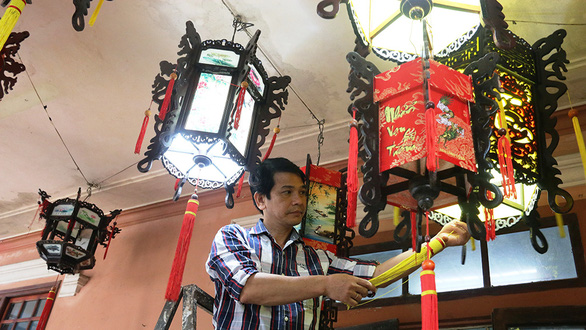Leaving his job as an interior designer in the hustle and bustle of Ho Chi Minh City behind, Nguyen Ngoc Man came back to the ancient capital of Hue with a determination to revive his family’s long-lost craft of making royal lanterns.
Against all odds, Man’s traditional lanterns have gone beyond Vietnam’s territory, hitting markets in Japan, South Korea, Thailand, France, the U.S., and more.
The journey of giving up to start
Man’s workshop hides inside a small village by the Huong River in Huong Long Ward, Hue City’s mother river.
“Before COVID-19, there used to be some 50 people working at the same time to fill up all the international orders. Since the pandemic, the workforce has been reduced as it has got harder to export goods and the demand has dropped significantly,” said Man.
COVID-19 is just another challenge for Man on his journey of giving up a stable job which secured him a comfortable life in a big city to search for a lost craft.
“My grandfather is artisan Nguyen Ngoc Giao, who made lanterns for the Imperial City of Hue under the Nguyen Dynasty. Later, due to economic hardship, his followers switched jobs to earn other livelihoods. The traditional lantern-making craft had gradually disappeared even before we realized,” said Man.
Settling down in Hue, the first thing Man did was pay a visit to the imperial city to examine dragon-decorated hexagon lanterns hung in Thai Hoa Palace, which were made for royalty by his grandfather.
Man wanted to make a similar lantern which required special skills in shaping bamboo strips and structuring wood frames.
“I searched for my grandfather’s students in vain. They all left the city. Fortunately, when cleaning the house, I accidentally discovered his old notebook with very detailed illustrations and explanations on how to construct traditional lanterns,” said Man.
After a month of trial and error, Man completed his first hexagon lantern which was later sold for VND25 million (US$1,080).
“It was a boost for me to start up, hire workers and devote my life to the craft,” said Man.
Reaching further
For 20 years of pursuing this path, Man has developed more than 100 models of lanterns that reflect Hue City’s nature.
“Hue lanterns have their structure built from curated pine wood, making them more durable to the changing weather of the city. We use brocade fabric or silk to wrap around structures and then draw patterns by hand,” Man explained the procedure.
At first, to approach the local market, Man consigned his lanterns at souvenir shops in Hue City.
It was surprising to him that many shop owners fell in love with his works and asked to buy them for resale.
“In 2014, when exhibiting my lanterns in Hanoi, I befriended a Japanese architect," Man recalled.
"He ordered hundreds of items to decorate restaurants and hotels in Japan.
"That was how my first international order was placed."
After that milestone, Man was invited to Tokyo to directly sell lanterns to Japanese customers.
Man said they paid close attention to the meaning of decorations which reimagined the Huong River, the Ngu Mountain, Hue’s beautiful landscapes and calligraphy in association with Buddhism in Hue.
“I think they bought my lanterns not only because of their beauty but also Vietnamese cultural values immersed in every work,” said Man.
Pham Thi Quynh Giao, head of Hue City’s Office of Culture and Information, highly appreciates Man’s lanterns for their esthetic value.
In Hue Traditional Craft Festivals, organizing boards always prioritize ordering his lanterns as a way to promote and introduce Hue’s culture to the public.
“Man is among a few artisans devoting his life to reviving the craft. That became the reason for us to choose his works to showcase at these important events,” said Giao.
Like us on Facebook or follow us on Twitter to get the latest news about Vietnam!




























